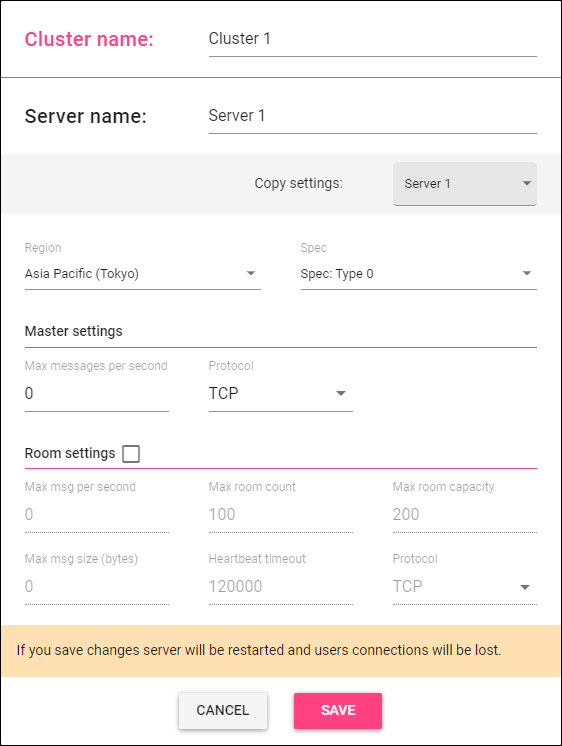Tuning Parameters¶
Strix Cloud has several parameters that you can adjust for a particular game. You can configure those values on Applications Dashboard.

In early stages of a game development, it is usually sufficient to run a cluster of a single Type 0 instance that runs both as a master server and a room server. It is also recommended to set all tuning parameters of each server to their default values during the stages. Default values should serve most of the games reasonably well.
During the development of a game, when its core online features start working, it is a good timing to run a stress test to measure and understand the server load. Server-side load metrics are available on Servers Page and Statistics Page on Applications Dashboard.
Combine the CCU (concurrent users = number of connecting clients) during the stress test and the expected CCU plan for the real service to estimate the number of servers and instance spec required for the real service.
Room Server loads can be adjusted by increasing or decreasing the number of room server instances and/or upgrading or downgrading instance spec. Also, you can adjust Max Room Count and/or Max Room Capacity to give appropriate load for each room server.
There is no set limit on the number of room servers in a cluster.
If you want to keep the room server configuration unchanged and let the game client to lower the loads of room servers, it is useful to know the number of messages in a second per client. You can calculate this metrics from the graph of Sent Messages available on Statistics Page by setting Range to “Last 3 hours” and Scale to “1 minute” and from the following formula:
<msgs in a sec per client> = (<sent messages> ÷ 60) ÷ (CCU × CCU)
Consulting the value, adjust the properties of StrixReplicator component in SDK, for example, or redesign the ways to synchronize game states to reduce the number of messages.
Note
In most of the games, heavy loads are generated by messages for synchronization and replication. When a room server receives such a message sent from a client, it usually resends a message to all clients. So, the above formula divides by (CCU × CCU) but just CCU to estimate the number of messages a single client sends out.
A single cluster can’t have multiple master servers. So, if the master server experiences a heavy load, try the followings:
If the instance for the master server also runs a room server, stop running a room server on the same instance.
Upgrade the instance spec.
If the master server is still under the too heavy load, consider splitting a cluster.